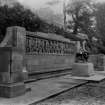Edinburgh, West Princes Street Gardens, Scottish American War Memorial
War Memorial (20th Century) (1927)
Site Name Edinburgh, West Princes Street Gardens, Scottish American War Memorial
Classification War Memorial (20th Century) (1927)
Alternative Name(s) American Memorial
Canmore ID 116463
Site Number NT27SE 1248
NGR NT 25097 73764
Datum OSGB36 - NGR
Permalink http://canmore.org.uk/site/116463
- Council Edinburgh, City Of
- Parish Edinburgh (Edinburgh, City Of)
- Former Region Lothian
- Former District City Of Edinburgh
- Former County Midlothian
Scottish American War Memorial [NAT]
OS (GIS) MasterMap, June 2010.
Architect: Reginald Fairlie, 1928 (with R Tait MacKenzie).
RCAHMS Print Room: Inglis Photograph Collection, Acc No 1994/90
Seen from the South:
2 general views (11 prints)
3 views of the central figure (7 prints)
2 details of the bas-relief (5 prints)
studio picture of the bas-relief (5 prints)
model for left part of bas-relief
General view from the west, Princes Street buildings behind (2 prints)
Seen from the East:
2 general views (19 prints)
detail of central figure (3 prints)
Study for the central figure:
general view from the front
the head in profile (16 prints)
(Undated) information in RCAHMS.
Project (1997)
The Public Monuments and Sculpture Association (http://www.pmsa.org.uk/) set up a National Recording Project in 1997 with the aim of making a survey of public monuments and sculpture in Britain ranging from medieval monuments to the most contemporary works. Information from the Edinburgh project was added to the RCAHMS database in October 2010 and again in 2012.
The PMSA (Public Monuments and Sculpture Association) Edinburgh Sculpture Project has been supported by Eastern Photocolour, Edinburgh College of Art, the Edinburgh World Heritage Trust, Historic Scotland, the Hope Scott Trust, The Old Edinburgh Club, the Pilgrim Trust, the RCAHMS, and the Scottish Archive Network.
Photographic Survey (1 October 2006)
The figure and relief, 1924-27 by Robert Tait Mackenzie, a Scots Canadian. Architect Reginald Fairlie (1883-1952) designed the setting. The statue was donated by Americans of Scots Ancestry as a memorial to Scots who fougt in WWI.
Photographed as a part of the wider survey of structures in Princes Street Gardens.
RCAHMS (CAJS) 2012.
Field Visit (22 September 2008)
A bronze kilted figure with a rifle across his knee is seated on a stone pedestal. He looks up with an earnest gaze towards Edinburgh Castle. Behind the statue is a long retaining wall with a bronze relief in three sections depicting the call to arms: at the front are the pipes and drums; behind is a recruiting party, and at the back are men from all walks of life, including miners, shepherds and fishermen ('a cross section of manhood of Scotland in 1914'). Above the frieze (at the top of the wall) are two intertwined wreaths, each containing a shield; one bearing the stars and stripes the other the St Andrew's Cross. On the piers of the retaining wall, to each side of the frieze, are carved thistles.
In 1923, after a lunch given to Colonel Walter Cameron of Lochiel, who had talked about the Cairn of Culloden and the deaths of his clansmen in the Great war; John Gordon Gray (who had been born in Scotland and was a president of the St Andrew's Society) put forward the idea of restoring the Cairn. This idea was later abandoned for a memorial to be erected in Edinburgh to commemorate the Scottish effort in the Great War. A committee was formed in America to raise funds, by people of Scots blood and sympathy.
Robert Tait Mckenzie was the sculptor of the statue and the bas-relief, which were cast at the Roman Bronze Works in Brooklyn, New York; Reginald Fairlie was the architect, and Messrs Colin Macandrew the builders. Alexander Carrick was employed on the stone carving and lettering.
The memorial was unveiled on 7 September 1927 by the American Ambassador A. B. Houghton.
The statue does not represent any specific regiment: the Lion of Scotland is carved on the soldier's sporran.
Inscriptions : On the front (south side) of the pedestal (incised letters):
THE CALL / 1914 / A Tribute / From Men and Women of Scottish Blood and Sympathies / In the United States of / AMERICA / TO / SCOTLAND / A People that Jeoparded their Lives unto the Death / in the High Places of the Field JUDGES . V . 18
Below the frieze (carved on the wall in raised letters):
IF IT BE LIFE THAT WAITS I SHALL LIVE FOREVER UNCONQUERED IF DEATH I SHALL DIE AT LAST STRONG IN MY PRIDE AND FREE
On a plaque [added by the City of Edinburgh Council] attached to the east end of the wall (raised letters):
This memorial was initiated by the Scottish-American War / Memorial Committee. The statue and bas-relief were / sculpted by Canadian Robert Tait Mackenzie [sic.] (1867-1938) / and cast at the Roman Bronze Works, Brooklyn, New York. / Mackenzie [sic.] was a physician and Director of Physical / Education at the University of Pennsylvania. // The Craigleith sandstone setting was designed by / architect Reginald Fairlie. // The memorial was unveiled on the 7th September 1927 by / U.S. Ambassador Houghton, who was given the Freedom of Edinburgh. The text is from 'A Creed', written at Vimy Ridge / in 1916 by Lieutenant E. Alan Mackintosh [sic.] M.C., 1893-1917, / 5th Seaforth Highlanders, 51st (Highland) Division, poet.
Signatures : On the back of the seated soldier, below his coat (raised letters):
R. Tait McKenzie / 1923 - 27
Bronze relief signed bottom right corner (incised letters):
ROMAN BRONZE WORKS N-Y-
Bronze relief signed bottom left (incised letters):
R.Tait McKenzie / fecit. 1924 - 1927
Inscription signed bottom right (incised letters): A. E. MACINTOSH [sic.]
Design period : 1923 - 1927
Year of unveiling : 1927
Unveiling details : 7 September 1927
Information from Public Monuments and Sculpture Association (PMSA Work Ref : EDIN0182)
































































































































































